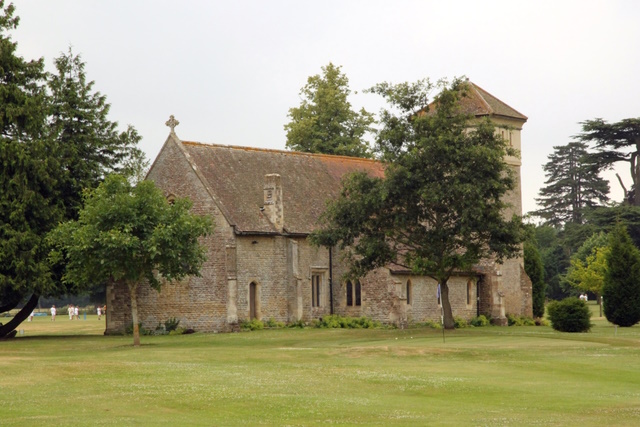


























St. Mary's Church, Hardwick
St. Mary's Church in Hardwick comprises a chancel, nave, and south aisle, with a south porch and western bell-turret. A late 12th- or early 13th-century doorway forms the main (south) entrance to the church and an ancient stoup, discovered built into some masonry, has been placed inside it. The chancel is 14th century with three original windows including a three-light east window and a low side window. There is a priest's door and piscina. The nave, also originally 14th century, is now mainly 15th century, with a fine west window. The South aisle and its arcade, the porch and bell-turret are 19th century. When Rawlinson visited the church in about 1718 he noted it as a 'small chapel going to decay'. In 1757 some minor repairs to the fabric were ordered; in 1812 it was declared to be 'out of repair'; in 1847 the rural dean reported the state of the church as 'moderately decent'. In 1877 the 2nd Earl of Effingham undertook at his sole charge a thorough restoration and also the enlargement of the church in accordance with the plans of Sir George Gilbert Scott. The work was carried out on the death of Sir George by his son G. G. Scott between 1878 and 1879 at a cost of £2,000. The completed building was a notable example of mid-Victorian restoration. The chancel walls were scarcely touched, but the nave was largely rebuilt: as far as possible the timbers of the old roof were preserved and the west window, the greater part of which had been blocked up, was restored to its original size. The south aisle, porch, and bell-turret were added. A new altar, font (from Fringford church), pulpit, and lectern were provided: the woodwork is good. An organ was added in 1900. There are two panels of medieval glass (Christ in majesty and the Crucifixion) in the west window, and there is ancient glass in the three top lights of the east window. There are inscriptions to Capt. Francis Hereman (d. 1687); Ralph Hatton (d. 1694/5) and Mary his wife (d. 1717); Ann, wife of Nicholas Saers of London (d. 1721); Samuel Tooley (d. 1721/2); and three to members of the Freeman family: Ursula (d. 1726/7), her son Basil (d. 1722), and his wife Winifred (d. 1751). There is a brass to Henry Howard, 2nd Earl of Effingham (d. 1889), and a brass and memorial window to Eliza, Countess of Effingham (d. 1894). Inscriptions to Ann, wife of William Lyne (d. 1622/3), John Pennington (d. 1680), and Pascha Bat (d. 1672) are no longer visible, nor are those to the 18th-century Roman Catholic Days, though there are floor slabs to other Roman Catholic families. In 1552 the church possessed a small silver chalice and paten. In 1955 it had some fine plate, given by the earls of Effingham in the late 19th and 20th centuries: a beautiful Elizabethan silver chalice (1562) and paten cover; a silver tankard flagon (1704), from a London church; a large early 18thcentury paten; and a tray and two cruets, the latter apparently of Spanish workmanship. There were in 1552 two bells and a sanctus bell, the last provided by a bequest from William Baker (1533). In 1955 one bell hung in the turret: probably originally an early 14th-century bell, it was recast in 1873. The registers begin in 1760, and there are incomplete transcripts from 1739. Historical information about St. Mary's Church is provided by British History Online. 'Parishes: Hardwick', in A History of the County of Oxford: Volume 6, ed. Mary D Lobel (London, 1959), pp. 168-173. British History Online http://www.british-history.ac.uk/vch/oxon/vol6/pp168-173 [accessed 14 April 2023]. St. Mary's Church is listed Grade II*. For more information about the listing see CHURCH OF ST MARY, Hardwick-with-Yelford - 1368277 | Historic England. For more information about St. Mary's Church see Parishes: Hardwick | British History Online (british-history.ac.uk). |

